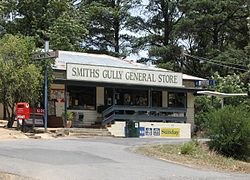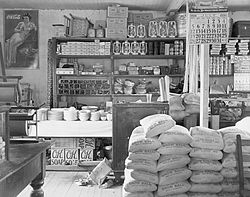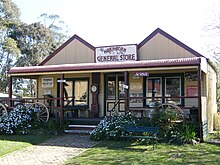General store: Difference between revisions
→India: cite |
→Further reading: cite |
||
| Line 86: | Line 86: | ||
==Further reading== |
==Further reading== |
||
* Dannhaeuser, Norbert. "The role of the neighborhood store in developing economies: the case of Dagupan City, Philippines." ''Journal of Developing Areas'' (1980): 157-174. [http://www.jstor.org/stable/4190748 in JSTOR] |
|||
| ⚫ | |||
* Kaynak, Erdener, and S. Tamer Cavusgil. "The evolution of food retailing systems: contrasting the experience of developed and developing countries." ''Journal of the Academy of Marketing Science'' (1982) 10#3 pp: 249-268. |
|||
| ⚫ | |||
* English, Linda. ''By All Accounts: General Stores and Community Life in Texas and Indian Territory.'' (University of Oklahoma Press, 2013) |
* English, Linda. ''By All Accounts: General Stores and Community Life in Texas and Indian Territory.'' (University of Oklahoma Press, 2013) |
||
Revision as of 07:31, 9 June 2014

A general store, general merchandise store, general dealer or village shop is a rural or small town store that carries a general line of merchandise.[1] It carries a broad selection of merchandise, sometimes in a small space, where people from the town and surrounding rural areas come to purchase all their general goods. The store carries routine stock and obtains special orders from warehouses. It differs from a convenience store or corner shop in that it will be the main shop for the community rather than a convenient supplement.
Bodeguita comes from the Spanish language as a diminutive of bodega which means "small store" or "small warehouse". Traditionally, Bodeguita existed selling general merchandise, then they were replaced slowly by the chain store, the same way large US chains have practically eliminated the "mom and pop" store.

General stores often sell staple food items such as milk and bread, and various household goods such as hardware and electrical supplies. The concept of the general store is very old, and although some still exist, there are far fewer than there once were, due to urbanization, urban sprawl, and the relatively recent phenomenon of big-box stores. The term "general merchandise store" is also used to describe a hybrid of a department store, with a wide selection of goods, and a discount store, with low prices. Examples include J. C. Penney and Sears.[2]
By country
Australia

While a large number of general stores still exist in Australia, as in other parts of the world their numbers were greatly reduced by the advent of supermarkets.
Canada
In Canada the French term dépanneur is used for a general store in Quebec. The oldest continually run general store in Canada is Trousdale's, located in Sydenham, Ontario, which has been operated by the Trousdale family since 1836. Socialbility has always been a feature, as locals come to chat as well as buy.[3]
India

In India, a tapri is a regional version of a general store. It stores all home, personal, medical, and hygienic daily used products. Many Kirana shops sell products other from food, such as clothing or household items, stationery, toys, tools, and medicines. Small Kirna stores, which are generally located on the corner of streets and generally known as katta or tapri, sell cigarettes, tobacco, and tea.[4]
United Kingdom

Village shops have become increasingly rare in the densely populated parts of England, although they remain common in remote rural areas of Scotland, Wales and Northern Ireland along with some lesser populated areas of England such as North Yorkshire, Northumberland and The Lake District.
Their rarity in England is due to several factors, such as the rise in car ownership, competition from large chain supermarkets, the rising cost of village properties, and the increasing trend of the wealthy to own holiday homes in picturesque villages, consequently these houses which used to be occupied full-time by potential customers are often vacant for long periods.
Of those villages in England who still have shops, these days they are often a combination of services under one roof to increase the likelihood of profit and survival. Extra services may include a post office, private business services such as tearooms, cafes, and bed and breakfast accommodation; or state services such as libraries and General Practitioner (GP) or Dental clinics; and charity partners such as Women's Institute (WI) coffee mornings held on the day most elderly villagers might collect their weekly pensions.
Some villages now have neither shop nor post office, but the village pub has largely survived (although recent economic downturns and changed drinking laws have begun to impact upon and change the survival of even this village stalwart[original research?]) and these often function as small shops or post offices as well. Many village pubs have become notable dining experiences, attracting trade from their villagers, tourists and nearby town dwellers with their trendy chefs or local produce/organic menus. In village areas close to Towns and Cities with a modern, mixed ethnic picture, out of town dining experiences of an ethnic kind have become popular in former pub premises. Most notable are large Indian and Chinese restaurants in areas such as Leicestershire, in the English East Midlands.
Community shops have become popular in some villages, often jointly owned and run by many villagers as a co-operative. The Village Retail Services Association ([1]) promotes the role and function of the village shop in the UK. Many modern village shops choose to stock items which draw in customers from neighbouring areas who are seeking locally sourced, organic and specialist produce such as local cuts of meat, local cheeses, wines etc.
In towns and cities, the corner shop has largely survived by dominating the local and light night convenience market.
The 1970s saw the death of the traditional grocery shop, which would have once dominated in the kind of buildings most corner shops operate from today, such old traditional family grocery stores began to face competition on two fronts: on the one hand from immigrant-owned corner shops, trading longer hours (typically British Asian families), and on the other from the rise of the supermarket, which amalgamated many specialist retailers such as butchers, bakers, and grocers under one roof at increasingly cheaper prices and with room for a greater choice of products. With the gradual loss of the traditional grocers came the loss of many aspects of old British shopping culture such as grocery deliveries and being enabled to have a "Tic" account with the grocer, a form of unofficial advanced credit. The cornershop is now much more the local convenience shop than the family grocer of days gone by.
Cornershops are usually so called because they are located on the corner plot or street end of a row of terraced housing, often Victorian or Edwardian factory workers' houses. The doorway into the shop was usually on the corner of the plot to maximise shop floor space within, this also offered two display windows onto two opposing streets. Many have now altered the original shop front layout in favour of a mini-supermarket style. Although it is common that cornershops found in the UK were former grocer shops, other specialist retailers also occupied such slots and have suffered the same fate of being largely replaced by super and hypermarkets, such retailers as greengrocers, bakers, butchers and fishmongers.
In popular culture
Many British TV and radio series, especially soap operas, feature corner shops or village shops as cornerstones for community gatherings and happenings. Prominent examples are the Village shop in Ambridge, the fictional village in the BBC Radio 4 series, The Archers, (1950–present day). Or the ITV1 soap opera Coronation Street (1960–present day) featuring a cornershop; it was owned, until recently, by Alf Roberts the grocer and after his death in the late 1990s was bought by Dev Alahan, reflecting this common change in British culture. The dying days and changing culture of the traditional British grocer was explored to great effect in the BBC TV comedy series Open All Hours (1976–1985), set in the real suburb of Balby in Doncaster, the shop front used for the street scenes in the series does actually exist in the area and is a hair salon in reality. The BBC Scotland comedy series Still Game has a corner shop as a recurring location where characters can meet and gossip; the actor who plays its owner, Navid Harris (Sanjeev Kohli), plays a similar role as Ramesh in the Radio 4 comedy series Fags, Mags and Bags which is set entirely in Ramesh's shop.
The band Cornershop in part base their image on the perception that many convenience stores are now owned by British Asian people. In terms of British popular culture these media representations give some idea of the importance attached to local shops in the national psyche and as a mainstay of community life.
United States



General stores, and itinerant peddlers, dominated in rural America until the coming of the automobile after 1910. Farmers and ranchers depended on general stores that had a limited stock and slow turnover; they made enough profit to stay in operation by selling at high prices. Often farmers would barter butter, cheese, eggs, vegetables or other foods which the merchant would resell. Prices were not marked on each item; instead the customer negotiated a price. Men did most of the shopping, since the main criteria was credit rather than quality of goods. Indeed, most customers shopped on credit, paying off the bill when crops, hogs or cattle were later sold; the owner's ability to judge credit worthiness was vital to his success. The store was often a gathering point for local men to chat, pass around the weekly newspaper, and talk politics.[5]
In the South the general store was especially important after the Civil War, as the merchant was one of the few sources of credit available until the cash crops (usually cotton or tobacco) came in. there were very few towns or cities, so rural general stores and itinerant peddlers were the main sources of supply.[6][7][8]
During the first half of the 20th century, general stores were displaced in many areas of the United States by many different types of specialized retailers in trading towns and small cities. But from the 1960s through present, many small specialized retailers are in turn crushed by the so-called "category killers", which are "big-box" wholesale-type retailers large enough to carry the majority of best-selling goods in a specific category like sporting goods or office supplies.
However, the convenience inherent in the general store has been revived in the form of the modern convenience store and the hypermarket, which can be seen as taking the general store or convenience store concept to its largest possible implementation.
Examples
- Barker General Store
- Felt Cobblestone General Store
- Gray's General Store
- Harkin's General Store
- Hussey's General Store
- Jorgensen's General Store
- Lost River General Store
- Manion's General Store
- Mast General Store
- McClellan's General Store
- Mikulich General Store
- Ruddell General Store
- Simons General Store
- Saint James General Store
- Tioga Centre General Store
- Vorous General Store
- Welty's General Store
See also
Footnotes
- ^ North American Industry Classification (NAICS) 2002, "452 General Merchandise Stores (US)"
- ^ "America's top stores". Consumer Reports June 2010, p. 17.
- ^ Richard Bauman, "The La Have Island general store: Sociability and verbal art in a Nova Scotia community." Journal of American Folklore (1972): 330-343. in JSTOR
- ^ Piyali Ghosh, et al., "Customer expectations of store attributes: A study of organized retail outlets in India." Journal of Retail & Leisure Property 9.1 (2010): 75-87.
- ^ Lewis E. Atherton, The Frontier Merchant in Mid-America (University of Missouri Press, 1971).
- ^ Jacqueline P. Bull, "The General Merchant in the Economic History of the New South." Journal of Southern History 18.1 (1952): 37-59. in JSTOR
- ^ Glenn N. Sisk, "Rural Merchandising in the Alabama Black Belt, 1875–1917." Journal of Farm Economics 37.4 (1955): 705-715.
- ^ Roger Ransom, and Richard Sutch. "Credit merchandising in the post-emancipation south: Structure, conduct, and performance." Explorations in Economic History 16.1 (1979): 64-89; heavily statistical online
Further reading
- Dannhaeuser, Norbert. "The role of the neighborhood store in developing economies: the case of Dagupan City, Philippines." Journal of Developing Areas (1980): 157-174. in JSTOR
- Kaynak, Erdener, and S. Tamer Cavusgil. "The evolution of food retailing systems: contrasting the experience of developed and developing countries." Journal of the Academy of Marketing Science (1982) 10#3 pp: 249-268.
- Lejoyeux, Michel, et al. "Prevalence of compulsive buying among customers of a Parisian general store." Comprehensive psychiatry (2007) 48#1 pp: 42-46.
- English, Linda. By All Accounts: General Stores and Community Life in Texas and Indian Territory. (University of Oklahoma Press, 2013)
